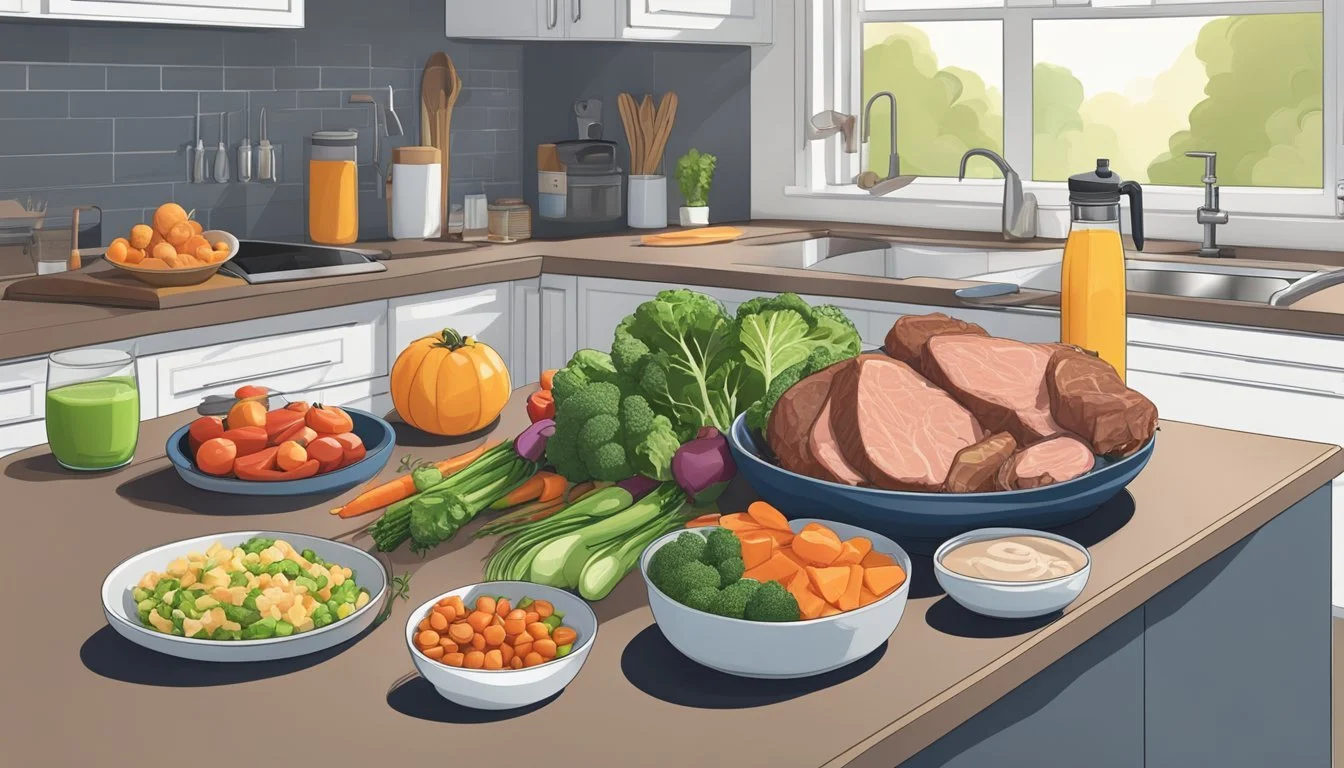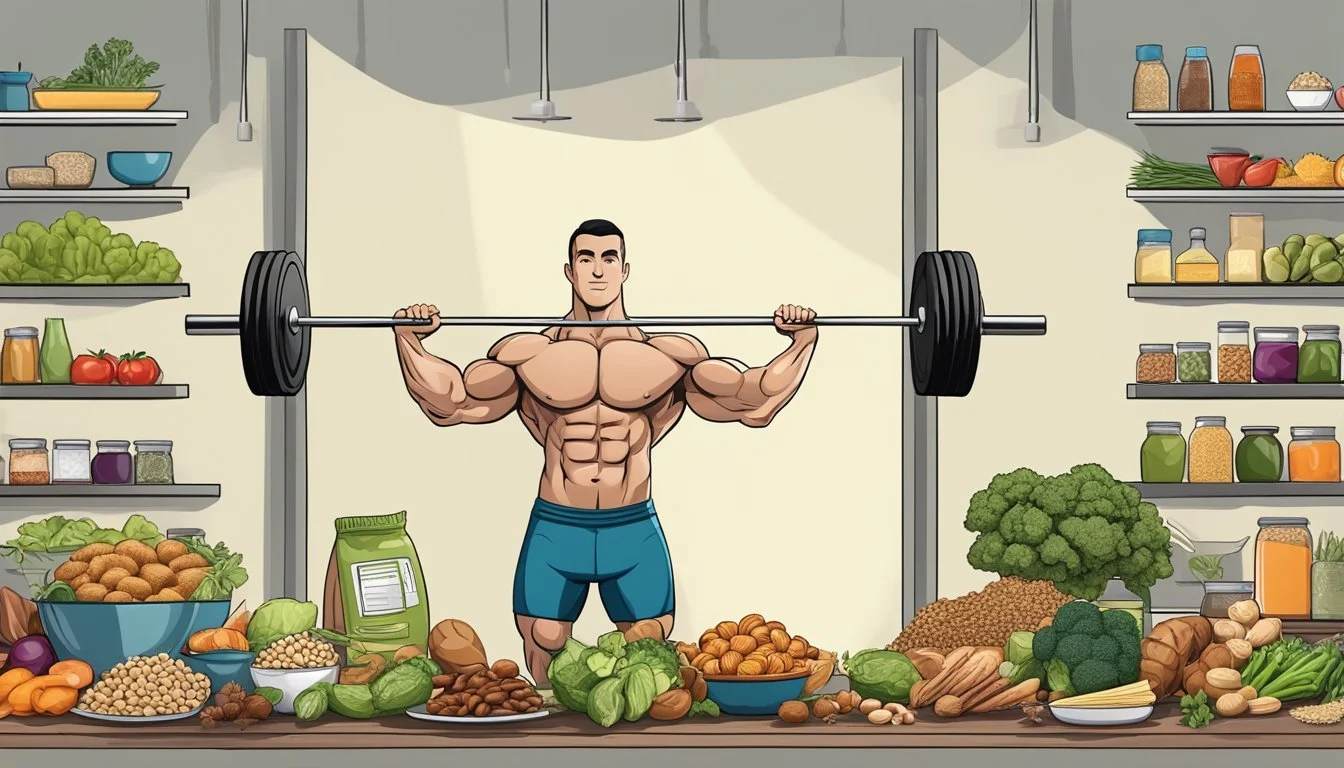How to Build Muscle on a Grain-Free Diet
Optimize Your Gain Without Grains
Building muscle on a grain-free diet presents a unique set of challenges and opportunities. Typically, fitness enthusiasts rely on grains for carbohydrates, which are crucial for energy during workouts and recovery. However, a grain-free diet requires alternative sources of carbs and nutrients that are essential for muscle synthesis. Those who choose to eliminate grains, perhaps due to dietary restrictions or personal preference, must carefully plan their meals to ensure they are consuming adequate proteins, healthy fats, and non-grain carbohydrate sources to fuel their muscle-building endeavors.
Adopting a grain-free diet does not hinder the ability to gain muscle mass, provided that one pays close attention to overall caloric intake and nutritional balance. Proteins are pivotal for muscle repair and growth, so individuals need to incorporate a variety of high-protein foods like meats, fish, eggs, dairy, and legumes. For energy and muscle glycogen replenishment, carbohydrates from fruits, vegetables, and tubers can be included. Simultaneously, fats from sources such as avocados, nuts (What wine goes well with nuts?), and seeds are essential for hormone regulation, including the hormones responsible for muscle growth.
This approach to dieting requires meticulous attention to food selection and meal timing to optimize workouts and recovery. Despite the absence of grains, the key principles of muscle building remain the same: sufficient calorie surplus, balanced macronutrient distribution, and progressive training stimulus. By ensuring these principles are met, fitness enthusiasts can successfully build muscle while adhering to a grain-free diet.
Building muscle on a grain-free diet is not only achievable but can also be highly effective for individuals seeking to optimize their fitness and well-being. By incorporating a variety of grain-free nutrient-dense foods, individuals can fuel their muscle-building endeavors while reaping the benefits of a grain-free nutritional impact.
Including options such as grain-free bread and grain-free granola in the diet provides a source of sustained energy and essential nutrients, catering to the needs of grain-free athletes and those focused on grain-free muscle building. Additionally, ensuring the inclusion of grain-free fiber from sources such as fruits, vegetables, and nuts supports digestive health and overall well-being.
By prioritizing lean proteins, healthy fats, and an array of fruits and vegetables, individuals can craft a well-rounded and nourishing diet that supports muscle growth and recovery. Embracing a grain-free diet for muscle building offers a pathway to achieving fitness goals while enjoying a diverse and satisfying range of wholesome foods.
Understanding Muscle Building Essentials
In building muscle on a grain-free diet, it's crucial to consider the balance of macronutrients and micronutrients, along with adequate hydration and overall caloric intake. These elements collectively support muscle synthesis and repair.
Role of Protein in Muscle Synthesis
Protein is the cornerstone of muscle development, providing the amino acids needed to build and repair muscle fibers. Those avoiding grains should focus on high-quality protein sources, such as meat, fish, eggs, and, for vegans, a variety of plant-based proteins like nuts and seeds. Consuming a mix of these proteins ensures a complete amino acid profile is achieved.
Importance of Fat and Carbohydrates
Fats are essential for hormone regulation and energy storage, which affects muscle growth. Avocados and nuts are excellent fat sources. Carbohydrates, while limited in a grain-free diet, are still available from fruits and vegetables, providing the necessary energy for workouts. Good carb choices include sweet potatoes and leafy greens, which are dense in nutrients and assist with energy metabolism without relying on grains.
The Significance of Micronutrients
Micronutrients, such as vitamins and minerals, play pivotal roles in muscle function and recovery. Magnesium, for example, is critical for muscle contraction and can be found in pumpkin seeds and spinach. A varied diet rich in vegetables and fruits ensures an adequate supply of these essential nutrients.
Hydration and Muscle Repair
Hydration is critical, with water serving as the primary beverage choice. It aids in nutrient transport and metabolic processes. Muscle repair is hampered without adequate fluid intake, so maintaining hydration is as vital as the macronutrient profile of the diet.
Overall Caloric Balance
For muscle gain, the body requires a surplus of calories. This doesn't mean consuming sugars or processed foods but rather ensuring that calorie intake from proteins, fats, and carbohydrates is sufficient to support muscle anabolism. Daily calorie needs will vary depending on individual metabolism and activity level.
Establishing a Grain-Free Diet Foundation
For fitness enthusiasts looking to build muscle while following a grain-free diet, understanding the foundation is crucial. This requires a clear definition of the diet, accurate knowledge of viable grain substitutes, the distinction between grain-free and gluten-free, and strategies to prevent potential nutrient deficiencies.
Defining a Grain-Free Diet
A grain-free diet excludes all types of grains, including whole grains such as wheat, barley, rye, oats, corn, and grain-like seeds like quinoa, amaranth, buckwheat, and millet. The focus of this diet is on other food groups that do not include these grains, prioritizing protein, vitamins, and minerals necessary for muscle development.
Analyzing Grain Substitutes
To ensure that the body receives enough nutrients for muscle growth, finding grain substitutes is vital. Prominent among these are:
Nuts and Seeds: High in protein and healthy fats.
Legumes: Include beans, lentils, and chickpeas, which are protein-rich.
Dairy Products: Provide protein and a range of vitamins and minerals.
Alternative Flours: Coconut, almond, and other nut-based flours can replace grain-based flours.
List of Grain Substitutes:
Nuts (e.g., almonds, walnuts)
Seeds (e.g., chia, flaxseed)
Legumes (e.g., lentils, black beans)
Dairy (e.g., milk, cheese)
Alternative flours (e.g., coconut flour, almond flour)
Grain-Free and Gluten-Free Differences
Contrary to some beliefs, grain-free does not mean gluten-free. A grain-free diet avoids all grains, whereas a gluten-free diet excludes only gluten-containing grains. People with celiac disease or non-celiac gluten sensitivity must adhere to a strict gluten-free diet, which includes avoiding wheat, barley, and rye but may allow for grains like corn and rice which are free from gluten.
Potential Nutrient Deficiencies and Solutions
Switching to a grain-free diet can result in deficiencies in fiber, B-vitamins, and certain minerals, as grains are a common source of these nutrients. It is essential to identify and incorporate other food sources or dietary supplements to meet the body's needs. Below are some solutions to potential nutrient deficiencies:
Fiber:
Increase intake of vegetables and fruits with skin/peel.
Include more nuts and seeds in the diet.
Vitamins and Minerals:
Consume a variety of fruits and vegetables to ensure a broad spectrum of nutrients.
Incorporate meat, fish, eggs, and dairy for B-vitamins and minerals like zinc and iron.
Consider fortified foods or supplements under a health professional's guidance to address specific nutrient gaps.
Designing a Muscle-Building Grain-Free Meal Plan
Designing a grain-free muscle-building meal plan requires attention to macronutrient ratios, quality protein sources, and strategic meal timing to ensure muscle growth and recovery without relying on grains for nutrition.
Macronutrient Ratios for Muscle Growth
For muscle growth, one needs to consume ample protein, a moderate amount of fats, and carbohydrates mostly from non-grain sources. An effective ratio to aim for might be 30% protein, 30% fat, and 40% carbohydrates. This distribution supports a balance in sustaining energy levels and fueling muscle synthesis.
Protein: 30%
Fat: 30%
Carbohydrates: 40%
Incorporating High-Protein Foods
High-protein foods are crucial for muscle repair and growth. On a grain-free diet, individuals should opt for:
Meats: such as chicken, turkey, and grass-fed beef
Fish: including salmon, mackerel, and tuna
Eggs: a complete protein source
Dairy: like Greek yogurt and cottage cheese (how long does cottage cheese last?)
Plant-Based Proteins: such as legumes, nuts, and seeds.
Protein should be distributed across all meals for continual muscle feeding.
Selecting Healthy Fats and Fiber Sources
Healthy fats and fibers are indispensable for overall health and satiety. Key sources include:
Fats: nuts, seeds, avocados, and high-quality oils like olive and coconut
Fibers: a variety of vegetables like leafy greens, bell peppers, and broccoli, as well as fruits with lower sugar content like berries.
Ensure that fiber intake is paired with adequate water consumption.
Meal Timing and Frequency
Consuming meals every 3 to 4 hours can sustain metabolism and muscle tissue building throughout the day. Including a source of protein with each meal is crucial for constant muscle recovery and growth.
Pre-Workout: Small meal rich in protein and fat for sustained energy
Post-Workout: Protein-focused meal or shake to aid muscle recovery
Supplements to Consider
In the context of a grain-free diet, certain supplements can help meet nutritional needs and support muscle building:
Whey or Plant-Based Protein Powders: for post-workout recovery
Branched-Chain Amino Acids (BCAAs): may assist in muscle recovery
Omega-3 Fatty Acids: can help reduce inflammation, sourced from fish oil or algae for vegetarians
Vitamins and Minerals: a quality multivitamin to ensure no nutritional gaps are present.
Strategies for Dealing with Dietary Restrictions
Building muscle on a grain-free diet requires careful selection of nutrient-dense foods and a strategic approach to common dietary challenges. It's imperative for individuals to devise a plan that addresses the potential obstacles while attending social events and finding substitute recipes for popular grain-based meals.
Managing Grain-Free Challenges in Social Settings
When attending social events, maintaining a grain-free diet can be challenging, as many gatherings feature foods like pizza, sandwiches, and pasta. Individuals should consider eating a protein-rich snack before attending to mitigate hunger and the temptation to indulge in grains. Options may include:
Boiled eggs
Nuts and seeds
Sliced vegetables with a grain-free dip
Upon arrival, they can gravitate towards grain-free dishes such as salads, soups, or seafood. It's also beneficial to communicate dietary preferences to the host in advance, which may encourage the inclusion of grain-free options.
Grain-Free Alternatives for Popular Dishes
Creating a satisfying grain-free menu involves identifying suitable replacements for beloved dishes that typically contain grains. Below is a table outlining grain-free alternatives for common meals and snacks.
Grain-Based Meal Grain-Free Alternative Pizza Cauliflower crust pizza with assorted toppings Pasta Spiralized vegetables or shirataki noodles with sauce Bread Lettuce wraps or portobello mushroom buns Cereal Mixed nuts with coconut flakes and almond milk Sandwich Stuffed bell peppers (What wine goes well with stuffed bell peppers?) or rolled deli meats (how long do deli meats last?) with leafy greens
For grain-free snack foods, consider items like olives, beef jerky, or dairy products like cheese, which are high in protein and fats. Additionally, smoothies made with a base of coconut milk or almond milk, incorporating ingredients like avocado, leafy greens, and a scoop of a grain-free protein powder, provide an excellent nutrient-dense snack or meal replacement.
Monitoring Your Progress and Adjusting as Needed
For those committed to building muscle on a grain-free diet, closely monitoring progress and making strategic adjustments is crucial. This means keenly observing muscle gains, body composition changes, and adhering to diet modifications to overcome plateaus, while also listening to the body's feedback to ensure health and effective muscle growth.
Tracking Muscle Gains and Body Composition
One should employ a structured approach to track fitness progress, utilizing methods such as body measurements, strength levels, and body fat percentage. For instance:
Weight training logs: Record weights lifted and repetitions completed.
Body measurements: Use a tape measure monthly to track changes in muscle size.
Body fat scales or calipers: Regularly assess body fat percentage.
This data provides a comprehensive view of how muscle development is progressing without grains and serves as the foundation for dietary adjustments.
Adjusting Your Diet for Plateaus
Encountering a plateau in muscle gain may necessitate dietary adjustments, focusing on caloric intake and macronutrient balance:
Increased calorie intake: If muscle gains stagnate, one might slightly raise calorie consumption from fat and protein sources.
Protein intake: They should ensure adequate protein intake to facilitate muscle repair and growth. The target is typically 1.6-2.2 grams per kilogram of body weight.
Fat and carb balance: Adjust the ratio of fats to any allowed carbohydrates to suit one's energy requirements, favoring sources that do not trigger gut inflammation.
Regular monitoring allows for timely interventions and helps maintain the delicate balance of energy needed for muscle development while on a grain-free regimen.
Listening to Your Body's Signals
Attention must be paid to signs that indicate whether dietary practices are sustainable for one's health:
Energy levels: Persistently low energy might suggest the need for more calories or a re-evaluation of macronutrient distribution.
Digestive health: Stomach pain, diarrhea, and bloating are clear signals that a certain food may not agree with one's system.
Overall well-being: Should they experience any sign of gut inflammation, the individual should reassess food choices and consider an alternative that is grain-free yet still nourishing and supportive of muscle growth.
Listening to the body and responding with appropriate dietary adjustments is fundamental in supporting both muscle development and overall health on a grain-free diet.
Potential Health Benefits and Challenges
In navigating the terrain of a grain-free diet to build muscle, one must weigh the potential health advantages against possible dietary challenges. It's essential to understand how this diet can impact not just muscle building but overall wellbeing, and to recognize and address any concerns that may arise.
Understanding the Benefits Beyond Muscle Building
A grain-free diet, often rich in legumes like beans, and other plant-based proteins such as tofu and tempeh, can be beneficial for muscle building. These protein sources are not only crucial for muscle repair and growth but also provide a variety of nutrients essential for overall health. Athletes may find that removing grains can reduce stomach pain or symptoms associated with inflammatory bowel disease, thereby enhancing digestion and nutrient absorption.
Addressing Possible Health Concerns
Shifting to a grain-free diet might lead to potential nutrient deficiencies due to the exclusion of whole grains, which are a natural source of fiber, vitamins, and minerals. It's critical that individuals ensure adequate intake of these nutrients through alternative foods or supplements. For those with health conditions such as diabetes, careful monitoring of blood sugar levels is crucial, as grain-free diets may alter carbohydrate intake.
Chronic Diseases and Inflammation
Grain-free diets can potentially reduce chronic inflammation—a risk factor for various chronic diseases including heart disease and metabolic syndrome. Some believe such diets might benefit individuals with autoimmune diseases by decreasing inflammation. However, scientific evidence should guide these choices, and medical advice is particularly important for managing chronic health conditions.
Mental Clarity and Mood Enhancement
Some individuals on grain-free diets report improvements in mental health, citing enhanced mental clarity and mood. Reductions in depression have also been anecdotally linked to grain-free living, potentially related to the diet's impact on energy levels and digestion. It's worth noting that the relationship between diet and mental health is complex and multifactorial, requiring further research to substantiate such claims.








